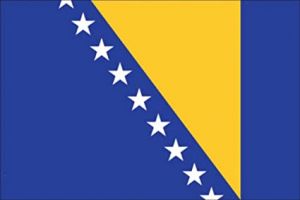Language/Bosnian/Vocabulary/Modes-of-Transportation
| ◀️ Ordering at a Restaurant — Previous Lesson | Next Lesson — Asking for Directions ▶️ |
Welcome to this exciting lesson on Modes of Transportation in Bosnian! Transportation is a vital part of our daily lives, allowing us to explore new places, commute to work, or simply visit friends and family. As you embark on your journey to learn Bosnian, understanding transportation vocabulary will not only enhance your language skills but also enrich your travel experiences in Bosnia and Herzegovina.
In this lesson, we will cover:
- A comprehensive list of transportation-related vocabulary
- Pronunciation guidance to help you sound like a local
- Practical exercises to reinforce your learning
- Conversational scenarios to practice using the vocabulary in context
By the end of this lesson, you’ll be equipped to discuss various modes of transportation and ask for directions—essential skills for any traveler. Let's get started!
Modes of Transportation Vocabulary
Transportation vocabulary is diverse and reflects the different ways we move from one place to another. Below, we’ll introduce you to 20 essential modes of transportation in Bosnian, complete with pronunciation guides and English translations.
| Bosnian | Pronunciation | English |
|---|---|---|
| auto | /ˈaʊto/ | car |
| autobus | /aʊˈtoʊbʊs/ | bus |
| bicikl | /ˈbɪt͡sɪkl/ | bicycle |
| tramvaj | /ˈtramvaɪ/ | tram |
| voz | /vɔz/ | train |
| avioni | /aˈvjɔni/ | airplane |
| brod | /brɔd/ | boat |
| motocikl | /ˈmotoˌt͡sɪkl/ | motorcycle |
| taxi | /ˈtæksi/ | taxi |
| podzemna željeznica | /pɔdzɛmna ˈʒɛljɛznitsa/ | subway |
| skuter | /ˈskuːtər/ | scooter |
| rikša | /ˈriːkʃa/ | rickshaw |
| kamion | /kɑːˈmiɔn/ | truck |
| helikopter | /ˈhɛlɪkɒptər/ | helicopter |
| čamac | /ˈtʃamats/ | canoe |
| skateboard | /ˈskeɪtbɔrd/ | skateboard |
| tramvajska stanica | /tramˈvaɪska ˈstanitsa/ | tram station |
| autobuska stanica | /aʊˈtoʊbʊska ˈstanitsa/ | bus station |
| aerodrom | /ˈɛəroʊdrɔm/ | airport |
| luka | /ˈluːkə/ | port |
As you can see, there are many different modes of transportation, each with its own unique characteristics. Whether you are talking about getting around the city or traveling long distances, knowing these terms will make your conversations more meaningful.
Practical Exercises
Now that you have learned the vocabulary, it's time to put it into practice! Below are some engaging exercises to help you reinforce what you've learned.
Exercise 1: Matching
Match the Bosnian terms with their English translations:
| Bosnian | English |
|---|---|
| 1. auto | A. airplane |
| 2. bicikl | B. boat |
| 3. brod | C. car |
| 4. avioni | D. bicycle |
Solution:
1. auto - C. car
2. bicikl - D. bicycle
3. brod - B. boat
4. avioni - A. airplane
Exercise 2: Fill in the blanks
Complete the sentences with the appropriate Bosnian transportation vocabulary.
1. I will take the ______ (bus) to the city center.
2. My brother rides a ______ (bicycle) every day.
3. We need to get to the ______ (airport) for our flight.
Solution:
1. autobusa
2. bicikl
3. aerodrom
Exercise 3: True or False
Determine if the statements are true or false.
1. "motocikl" means "boat". (False)
2. "tramvaj" is a type of train. (False)
3. "taxi" is the same in both English and Bosnian. (True)
Exercise 4: Create sentences
Using the vocabulary you learned, create three sentences about modes of transportation.
Example:
1. "Ja vozim bicikl u parku." (I ride a bicycle in the park.)
2. "Moja sestra putuje avionom." (My sister travels by airplane.)
3. "Idem na autobusku stanicu." (I am going to the bus station.)
Exercise 5: Role Play
In pairs, role-play a scenario where one person asks for directions to a transportation hub in Bosnian. Use the vocabulary learned in this lesson.
Example:
Person A: "Izvini, gdje je autobuska stanica?" (Excuse me, where is the bus station?)
Person B: "Autobuska stanica je lijevo od tebe." (The bus station is on your left.)
Exercise 6: Listening Comprehension
Listen to a short dialogue in Bosnian that includes transportation vocabulary. Write down the modes of transportation mentioned in the conversation.
Solution: (Based on the audio provided, students will note the terms they hear.)
Exercise 7: Vocabulary Quiz
Answer the following questions:
1. What is the Bosnian word for "truck"?
2. How do you say "I take the tram" in Bosnian?
3. What type of transportation is "helikopter"?
Solutions:
1. kamion
2. "Ja uzimam tramvaj."
3. It is an airplane.
Exercise 8: Transportation Dialogue
Write a short dialogue between two friends discussing their preferred modes of transportation.
Example:
Friend 1: "Kako putuješ do posla?" (How do you commute to work?)
Friend 2: "Ja vozim auto." (I drive a car.)
Exercise 9: Word Search
Create a word search puzzle that includes all the transportation vocabulary from this lesson.
Exercise 10: Group Discussion
In groups, discuss the advantages and disadvantages of different modes of transportation. Use the vocabulary learned in this lesson.
Conclusion
Congratulations! You've taken a significant step in your Bosnian language journey by mastering the vocabulary related to modes of transportation. Remember, practice makes perfect, and using these words in conversation will help solidify your understanding. Whether you're planning a trip to Bosnia or just looking to engage with the language, this knowledge will be invaluable.
Keep practicing, exploring, and enjoying the beauty of the Bosnian language!
Other Lessons
- Food and Drink
- Telling Time
- Greetings and Introductions
- Numbers
- Geography
- How to Say Hello and Greetings
- Common Greetings
- Drinks
- Education
- Numbers 1 100
| ◀️ Ordering at a Restaurant — Previous Lesson | Next Lesson — Asking for Directions ▶️ |

